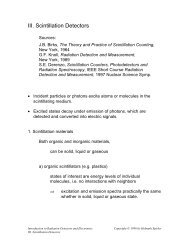VIII.2. A Semiconductor Device Primer
VIII.2. A Semiconductor Device Primer
VIII.2. A Semiconductor Device Primer
You also want an ePaper? Increase the reach of your titles
YUMPU automatically turns print PDFs into web optimized ePapers that Google loves.
This yields the solution<br />
n<br />
p<br />
( x)<br />
= n<br />
p0<br />
n<br />
( ) L x − /<br />
n ( 0)<br />
− n e<br />
From this we obtain the electron current entering the p-region<br />
J<br />
np<br />
= −q<br />
e<br />
D<br />
This says that the electron current is limited by the concentration<br />
gradient determined by the carrier density at the depletion edge np(0)<br />
and the equilibrium minority carrier density np0 .<br />
Determining the equilibrium minority np0 is easy<br />
n<br />
dn<br />
dx<br />
+<br />
p<br />
x=<br />
0<br />
The problem is that np(0) is established in a non-equilibrium state,<br />
where the previously employed results do not apply.<br />
p<br />
= q<br />
To analyze the regions with non-equilibrium carrier concentrations<br />
a simplifying assumption is made by postulating that the product<br />
pn is constant. In this specific quasi-equilibrium state this constant<br />
will be larger than ni 2 , the pn-product in thermal equilibrium.<br />
In analogy to thermal equilibrium, this quasi-equilibrium state is<br />
expressed in terms of a “quasi-Fermi level”, which is the quantity<br />
used in place of EF that gives the carrier concentration under nonequilibrium<br />
conditions.<br />
2<br />
i<br />
Introduction to Radiation Detectors and Electronics Copyright © 1998 by Helmuth Spieler<br />
<strong>VIII.2.</strong>a. A <strong>Semiconductor</strong> <strong>Device</strong> <strong>Primer</strong>, Doping and Diodes<br />
e<br />
n n / N<br />
p0<br />
=<br />
D<br />
A<br />
n<br />
p0<br />
n<br />
p<br />
( 0)<br />
− n<br />
L<br />
n<br />
p0





